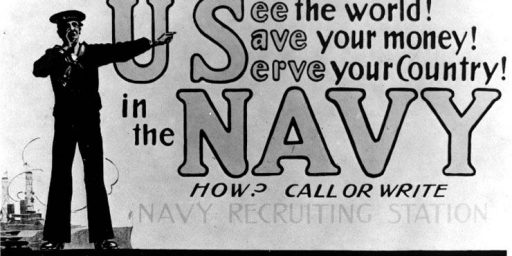Naval Affairs
Stephen Green points to this StrategyPage report on an alarming number of U.S. Navy ship captains being relieved for “zipper failure.” It’s interesting and stands without comment.
This portion struck me as odd, though:
It’s a hard slog for a new ensign (officer rank O-1) to make it to a ship command. For every hundred ensigns entering service, about 90 will stay and make it to O-4 (Lieutenant Commander), usually after about nine years of service. About 67 of those ensigns will eventually get to serve as XO (executive officer, the number two officer on a ship) after 10-12 years of service. Some 69 of those ensigns will make it to O-5 (Commander), where it first becomes possible to command a ship (a frigate or destroyer.) About 38 of those hundred ensigns will get such a command, usually after 18-20 years of service, and for about 18 months. About 22 of those ensigns will make it to O-6 (Captain) after 20-21 years of service. But only 11 of those ensigns (now captains) will get a major seagoing command (cruiser, destroyer squadron). Officers who do well commanding a ship will often get to do it two or three times before they retire after about 30 years of service.
Either those numbers are way off, it’s far easier to get promoted in the Navy than the Army, or things have changed radically in the twelve years since I hung up my uniform. Back in my day, we had an 87% selection rate for captain (O-3), only 65% or so saw major (O-4), and something over 50% made lieutenant colonel (O-5). If these figures are right, Navy officers are virtually assured O-5 rank? Given normal attrition for people who just aren’t cut out for a Navy career, it would be almost impossible not to make Commander if 69 of 100 of an accession year group cohort are selected.






im a serving enlisted member of the navy and can tell you that promotion to the O-3 level in the navy is automatic these days..as long as you have a pulse and havent had any “issues” along the way. However if also heard that alot of officers that washed from their ascession(SP?) program (ie pilots that washout of training) are getting booted without completing their initial obligation, and being left holding the bag on some pretty hefty financial obligations.
On the Air Force side, promotions to O-4 required only a pulse in early 1999 when I left active duty. That was, at least in part, a reaction to the massive reduction in force in the early 1990s that “hollowed out” a couple of year groups and discouraged a few more. At the time I left active duty (as an O-3), the Air Force was 39% manned in O-4s in my specialty area, and I’d been filling O-4 slots for most of the past four years.
I would also agree and say that after I left active duty in 2002, it was virtually assured that you would get O-5 in the Army, too…you may not get that command, but you would get O-5. The only MAJs that would retire at O-4 would be those who were prior service.
The StrategyPage article has faulty numbers, and reaches conclusion that are not supportable.
The most obvious problem is Junior Officer retention. 90% – NO WAY!
I just downloaded an Aug 03 briefing for my old Officer Community (1120) to find the real numbers. Retention of O-3s has been running from 28% in FY01, to 39% in FY03 (averaging around 33%). Goal is 38%. FY98 was 25%.
Looking at promotion to O-4, I was surprised. For line officers (vice staff officers) since FY01, basically any breathing surface and sub driver got promoted (rates ~90%), as opposed to 94-00, where the rates rarely pushed against 75%. However, aviators are at least 5% lower.
For O-5, through FY99, promotion was at the DOPMA 70%, but has climbed a little since then to about 80%. O-6 promotions are about 55% (not counting all the O-5s who retire earlier).
For the administrative screens for XO and CO, XO is running at ~60% for each (not including those chosen as alternates). So doing the math – for 100 ensigns, you get 12 becoming COs under today’s best numbers (assumed every serviced XO gets promoted, not unreasonable). These numbers are much higher than 6 years ago, when a retained O-3 had a 35-40% chance of screening for XO, and lower promotion rates (and if you don’t screen to XO, your odds of making O-5 are under 10%).
The author did not consider the possibility that with a smaller Navy (number of ships roughly cut in half since 1991), there are now plenty of qualified officers available to replace a relieved ship’s captain, so the higher ups are now less tolerant of questionable personal behavior on the part of a ship’s CO. Zero tolerance, and all that baggage. What would have been brushed under the carpet 15 years ago is now grounds for dismissal.
On the other hand, the Navy has become more tolerant of events happening over which the CO had little or no control, such as the USS COLE.
Jem’s right – I just beefed about this on VodkaPundit. I think the author was looking at promotion rates & assumed that % applied to the whole year group… I.e., since majors are in such short supply these days, the promotion rate is above 90%, but that doesn’t mean 90% of a given year group makes O-4, it’s 90% of the people _still in the service and eligible_ can get promoted. It doesn’t take into account the huge number of people who bail out after their initial committment before getting to the promotion boards…
The numbers are incorrect on their face: for one thing, they go from 67% to 69% at one point, when they should be going down as we discuss higher and higher ranks.
Or am I reading it wrong?–wasn’t the excerpt discussing ever-higher levels of achievement?
I think Legion’s explanation is probably right–it’s a percentage of the group up for promotion. It’s just not written very cleanly.
—